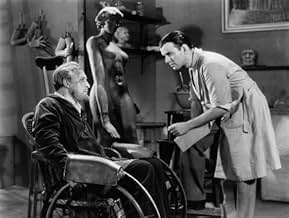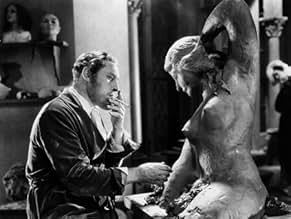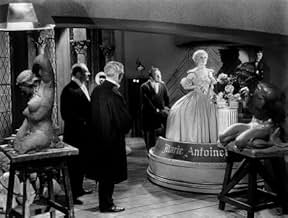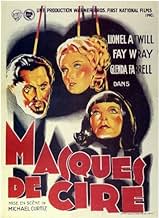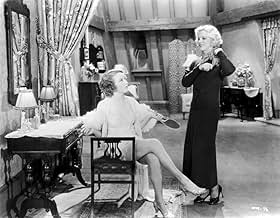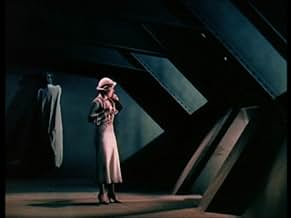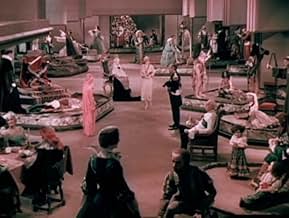ÉVALUATION IMDb
6,8/10
7,3 k
MA NOTE
La disparition de personnes et de cadavres conduit un journaliste dans un musée de cire et vers un sinistre sculpteur.La disparition de personnes et de cadavres conduit un journaliste dans un musée de cire et vers un sinistre sculpteur.La disparition de personnes et de cadavres conduit un journaliste dans un musée de cire et vers un sinistre sculpteur.
- Director
- Writers
- Stars
Thomas E. Jackson
- Detective
- (as Thomas Jackson)
Bull Anderson
- Janitor
- (uncredited)
Frank Austin
- Winton's Valet
- (uncredited)
Max Barwyn
- Museum Visitor
- (uncredited)
Wade Boteler
- Ambrose
- (uncredited)
Avis en vedette
This film, which was remade as "House Of Wax" 20 years later (as if you didn't know), might not enjoy quite the reputation it does today had it not been the basis for the better-known later film and, more importantly, believed lost for over 30 years, which made it something of a legend for many people who'd never even seen it. Legendary status can be rather difficult to live up to, and unless a viewer is approaching it with no advance knowledge of its history, MYSTERY OF THE WAX MUSEUM may not be quite what one expects.
It is, nevertheless, an energetic and entertaining amalgam of genres: horror film meets newspaper crime drama. Dropping a rather Gothic tale of body-snatching, a mad sculptor and a museum of wax-covered corpses into the streamline-moderne milieu of fast-talking, wise-cracking reporters on the trail of a hot story makes for interesting contrasts.
Lionel Atwill, as Ivan Igor, the artist driven to insanity and murder by the destruction of his wax "children" in an arson fire, was an immensely enjoyable performer whose best work came a bit later (see "Son Of Frankenstein" for his portrayal of the one-armed Insp. Krogh). His natural screen presence carries him through, though he never quite generates either the pathos or the smooth menace that Vincent Price displayed in the remake. But from the moment of her entrance, it's Glenda Farrell as Florence Dempsey, the reporter out to save her job by bringing in a scoop - barreling onto the screen with a full head of steam - who propels the story all the way to its finish.
There's an awful lot going on here beyond the basic premise; bootlegging, a "dope fiend," a suicide and a falsely implicated millionaire playboy are thrown into the mix, packing quite a lot into the 77 minute running time (the remake improved the story by eliminating extraneous characters and subplots). A pre-"King Kong" Fay Wray (in her naturally red hair sans the "Kong" blond wig) is the damsel in actual distress, but despite her billing, she's basically a supporting player and has little to do - beyond enduring roommate Florence's snide comments about her penniless boyfriend - until the climactic confrontation between all the bad guys and good guys (and girls).
MYSTERY is well-served by the direction of Michael Curtiz ("Adventures Of Robin Hood," "Casablanca"), who was something of a jack-of-all-genres, and there's plenty of snappy dialogue, some of which (Florence asking a cop, "How's your sex life?") wouldn't have made it to the screen a year later under the newly re-written Production Code. Depending on one's point of view, it could be said that the very effective production design either benefits, or suffers, from the pale pastels of the two-strip Technicolor photography. For my part, I'm guessing that the subdued tones we see today result from the lack of first-rate film elements available. Having seen far superior two-strip from years earlier, I'll wager that the original prints were much more vivid.
If you're any kind of a fan of the remake, you do owe it to yourself to see this one, if only once. There are many things to enjoy in MYSTERY OF THE WAX MUSEUM, not the least of which are the fabulous ensembles worn by Farrell. Just how does a newspaper reporter one step away from the breadline afford a wardrobe like that?
It is, nevertheless, an energetic and entertaining amalgam of genres: horror film meets newspaper crime drama. Dropping a rather Gothic tale of body-snatching, a mad sculptor and a museum of wax-covered corpses into the streamline-moderne milieu of fast-talking, wise-cracking reporters on the trail of a hot story makes for interesting contrasts.
Lionel Atwill, as Ivan Igor, the artist driven to insanity and murder by the destruction of his wax "children" in an arson fire, was an immensely enjoyable performer whose best work came a bit later (see "Son Of Frankenstein" for his portrayal of the one-armed Insp. Krogh). His natural screen presence carries him through, though he never quite generates either the pathos or the smooth menace that Vincent Price displayed in the remake. But from the moment of her entrance, it's Glenda Farrell as Florence Dempsey, the reporter out to save her job by bringing in a scoop - barreling onto the screen with a full head of steam - who propels the story all the way to its finish.
There's an awful lot going on here beyond the basic premise; bootlegging, a "dope fiend," a suicide and a falsely implicated millionaire playboy are thrown into the mix, packing quite a lot into the 77 minute running time (the remake improved the story by eliminating extraneous characters and subplots). A pre-"King Kong" Fay Wray (in her naturally red hair sans the "Kong" blond wig) is the damsel in actual distress, but despite her billing, she's basically a supporting player and has little to do - beyond enduring roommate Florence's snide comments about her penniless boyfriend - until the climactic confrontation between all the bad guys and good guys (and girls).
MYSTERY is well-served by the direction of Michael Curtiz ("Adventures Of Robin Hood," "Casablanca"), who was something of a jack-of-all-genres, and there's plenty of snappy dialogue, some of which (Florence asking a cop, "How's your sex life?") wouldn't have made it to the screen a year later under the newly re-written Production Code. Depending on one's point of view, it could be said that the very effective production design either benefits, or suffers, from the pale pastels of the two-strip Technicolor photography. For my part, I'm guessing that the subdued tones we see today result from the lack of first-rate film elements available. Having seen far superior two-strip from years earlier, I'll wager that the original prints were much more vivid.
If you're any kind of a fan of the remake, you do owe it to yourself to see this one, if only once. There are many things to enjoy in MYSTERY OF THE WAX MUSEUM, not the least of which are the fabulous ensembles worn by Farrell. Just how does a newspaper reporter one step away from the breadline afford a wardrobe like that?
A genuinely frightening film from Michael Curtiz, jack of no trades and master of all. Many of the tricks of classic 1930's horror are here, including the opening scene set in a dark, rainy London street, the long shadows on the wall, lengthy periods of silence, and all timed to perfection. Only the faster-than-the-speed-of-sound dialogue of Glenda Farrell truly lets the film down. But other than that it is a gothic masterpiece, an underrated movie probably due to the fact that it lay undiscovered, thought lost, for over half a century. Far more inventive and imaginative than the majority of horror films made today.
Considering the fact that this 1933 movie was produced during the depression, when moviegoers expected pure entertainment, the results were exactly what they wanted. Glenda Farrell's hard-boiled Florence Dempsey was what filmgoers were looking for. Please note that many of the movies of the period had male and female stars who were fast talkers and wise-crackers. Such stars as Cary Grant, Carole Lombard, Rosalind Russell, Bette Davis, James Cagney, Mae West, W. C. Fields, William Powell, Myrna Loy, etc. were the norm and not the exception.
This wonderful movie was way ahead of its time. It's two-color look was also something very different for the 1930s and its washed-out looked helped give it a more sinister appearance. The later "House of Wax" used 3-D and having seen it in the movies I can tell you it was probably the best of the 3-D movies. Even better than "The Creature from the Black Lagoon".
Fay Wray was pure candy and she practiced her scream well for the upcoming "King Kong". I have seen most of Lionel Atwill's work and I believe the underplaying of Ivan Igor helped make him a more credible monster. The movie was well cast and one can not help but notice the uncanny fact that most of the actors in "The House of Wax" were chosen because they looked like the earlier actors except for the difference between Charles Buchinsky (Bronson) and Matthew Betz as the loyal mute assistant.
Although enjoyable, "The House of Wax" was no match for the earlier edition. It's understandable that "The House of Wax" did not use the characters of Florence Dempsey and Gavin Gordon. Sidekicks didn't work as well as in the 50s.
I wonder what the movie critics of the 30s thought of the "Mystery of the Wax Museum?"
This wonderful movie was way ahead of its time. It's two-color look was also something very different for the 1930s and its washed-out looked helped give it a more sinister appearance. The later "House of Wax" used 3-D and having seen it in the movies I can tell you it was probably the best of the 3-D movies. Even better than "The Creature from the Black Lagoon".
Fay Wray was pure candy and she practiced her scream well for the upcoming "King Kong". I have seen most of Lionel Atwill's work and I believe the underplaying of Ivan Igor helped make him a more credible monster. The movie was well cast and one can not help but notice the uncanny fact that most of the actors in "The House of Wax" were chosen because they looked like the earlier actors except for the difference between Charles Buchinsky (Bronson) and Matthew Betz as the loyal mute assistant.
Although enjoyable, "The House of Wax" was no match for the earlier edition. It's understandable that "The House of Wax" did not use the characters of Florence Dempsey and Gavin Gordon. Sidekicks didn't work as well as in the 50s.
I wonder what the movie critics of the 30s thought of the "Mystery of the Wax Museum?"
Classic horror movie directed by Michael Curtiz and starring Lionel Atwill as a deranged sculptor with an "interesting" method of making the statues on display at his wax museum. The last (and best) of the three horror movies Lionel Atwill did with Fay Wray. Atwill is fantastic here and Wray is, as always, delightful. Nice support from Frank McHugh, Gavin Gordon, and Edwin Maxwell, among others. The scene stealer of the movie is Glenda Farrell as the fast-talking reporter heroine. She really has fun with the part. A few years later she would star in the Torchy Blane series and play a character very similar to the one she plays here.
It's a good-looking movie, filmed in two-color Technicolor with nice atmospheric direction from Curtiz. The sets are great, especially Atwill's art deco laboratory. The makeup effects are terrific. It's a juicy Pre-Coder, as evidenced by the gruesome plot and the junkie character played by Arthur Edmund Carewe. Some viewers might be put off by the fact that a large chunk of the middle of the picture is more like a crime story/newspaper movie but I was always entertained, particularly by the back & forth between Farrell and McHugh. So it's not a straight horror movie from beginning to end but, so what, it's still a great film and worth a look. Remade in the '50s as House of Wax with Vincent Price. That version is more well-known than this one but I like rewatching this one more. It's just more fun.
It's a good-looking movie, filmed in two-color Technicolor with nice atmospheric direction from Curtiz. The sets are great, especially Atwill's art deco laboratory. The makeup effects are terrific. It's a juicy Pre-Coder, as evidenced by the gruesome plot and the junkie character played by Arthur Edmund Carewe. Some viewers might be put off by the fact that a large chunk of the middle of the picture is more like a crime story/newspaper movie but I was always entertained, particularly by the back & forth between Farrell and McHugh. So it's not a straight horror movie from beginning to end but, so what, it's still a great film and worth a look. Remade in the '50s as House of Wax with Vincent Price. That version is more well-known than this one but I like rewatching this one more. It's just more fun.
In the early 30s, Hungarian director Michael Curtiz was still considered a recently arrived foreigner working at Warner Bros. after impressing legendary producer Jack Warner with his work in Germany. In those early days of his career in the U.S. Curtiz began to make himself a name as a hard working director who always managed to work effectively under the studio system, and it was with the success of the horror films, "The Mad Genius" and "Doctor X", when he proved to be not only effective, but also able to make box-office hits. It was really the success of "Doctor X" what prompted Warner Brothers to make another horror movie in the same style, with the same same cast, and keeping Michael Curtiz as director. The result was the now classic Technicolor thriller, "Mystery of the Wax Museum".
Ivan Igor (Lionel Atwill) is an extremely talented sculptor of wax figures in London, however, his employer thinks that Igor's business i snot making enough money for both of them, and starts a fire at Igor's Wax Museum in order to collect the insurance money. Thirteen years later, Ivan Igor is tragically crippled and unable to use his hands, but with the help of his students he is finally ready to reopen his museum in New York City. In the meantime, the police is baffled by the case of several corpses stolen from the City's morgue, including the one of a famous socialité. The case attracts the attention of Florence Dempsey (Glenda Farrell), a young reporter looking for her big story, and immediately she starts to investigate. Her suspicion will lead her to important clues, and Igor's strange obsession with Florence's roommate Charlotte (Fay Wray) will take her to uncover the strange mystery of the Wax Museum.
The key word in "Mystery of the Wax Museum" is "Mystery", as unlike it's better known 1953 remake (which focuses on horror and suspense), this version of Charles Belden's play behaves more like a simple, yet really captivating, tale of mystery where our main character, Florence, must discover who and more importantly "how" is committing the crimes. Adapted by Don Mullaly and Carl Erickson, the movie has a very original plot that unfolds nicely despite the fast pace of the film. The fact that it was written before the days of the Hays code allows the film to include lots of sexual innuendo and situations that later would be considered immoral. The characters are overall very well developed, and the addition of comedy (courtesy of Farrell's wisecracking character) works nicely with the creepy mystery of the story.
On of the lasts movies to be shot in the primitive two-color Technicolor system, it has a marvelous bleached look that works perfectly with the modernist art-deco style of the sets designed for the film. Director Michael Curtiz allows himself to show the influence he received when working in Germany during the years of expressionism, and gives the film an ominous dark look as Florence gets deeper inside the Wax Museum (although not as striking as what Universal Studios did with its horror films). It's worth to point out that while Curtiz may be better known as an effective director for hire under the studio system, he really shows a definite style in this film, and begins to give form to the elements that would later become part of his masterpiece, "Casablanca".
The cast is overall excellent, although it is of course difficult not to make comparisons with the performances of the better known 50s version. Lionel Atwill offers one of his most underrated performances of his career as Ivan Igor, and while he lacks the charm that Vincent Price would give to the role, he is very believable as the tortured artist, victim of misfortune. Glenda Farrell's turn as Florence Dempsey has been harshly criticized due to the comic nature of her character's persona, but honestly she makes a terrific job as the main character, vastly overshadowing the more famous Fay Wray; who while looking stunningly beautiful here, lacks the presence that would make her an icon in "King Kong".
While "House of Wax" tends to get the upper hand when compared to the original version, "Mystery" is by no means a bad movie, simply a different one. As written above, this movie focuses completely on the mystery aspect of the story, and while it does have its fair share of horrific elements, they are minimal when compared with the Gothic horror of "House of Wax". True, it certainly looks dated by today's standards, but the movie has a notorious modernist (in the architecture, designs, etc...) touch that may have looked futurist for the 30s society. The special effects are definitely less impressive than in the remake, but considering the times when they were done are still an excellent work, and some look really impressive thanks to the lavish Technicolor process.
Personally, I find in "House" and "Mystery" a classic example of what a remake should be, as the two are excellent movies that explore the same story under different angles. Fans tend to dismiss "Mystery", but I think it's equally as good as the legendary Vincent Price film. "Mystery of the Wax Museum" is a very interesting movie for fans of "House of Wax", and a definitive must-see for those interested in horror movies of the 30s. 8/10
Ivan Igor (Lionel Atwill) is an extremely talented sculptor of wax figures in London, however, his employer thinks that Igor's business i snot making enough money for both of them, and starts a fire at Igor's Wax Museum in order to collect the insurance money. Thirteen years later, Ivan Igor is tragically crippled and unable to use his hands, but with the help of his students he is finally ready to reopen his museum in New York City. In the meantime, the police is baffled by the case of several corpses stolen from the City's morgue, including the one of a famous socialité. The case attracts the attention of Florence Dempsey (Glenda Farrell), a young reporter looking for her big story, and immediately she starts to investigate. Her suspicion will lead her to important clues, and Igor's strange obsession with Florence's roommate Charlotte (Fay Wray) will take her to uncover the strange mystery of the Wax Museum.
The key word in "Mystery of the Wax Museum" is "Mystery", as unlike it's better known 1953 remake (which focuses on horror and suspense), this version of Charles Belden's play behaves more like a simple, yet really captivating, tale of mystery where our main character, Florence, must discover who and more importantly "how" is committing the crimes. Adapted by Don Mullaly and Carl Erickson, the movie has a very original plot that unfolds nicely despite the fast pace of the film. The fact that it was written before the days of the Hays code allows the film to include lots of sexual innuendo and situations that later would be considered immoral. The characters are overall very well developed, and the addition of comedy (courtesy of Farrell's wisecracking character) works nicely with the creepy mystery of the story.
On of the lasts movies to be shot in the primitive two-color Technicolor system, it has a marvelous bleached look that works perfectly with the modernist art-deco style of the sets designed for the film. Director Michael Curtiz allows himself to show the influence he received when working in Germany during the years of expressionism, and gives the film an ominous dark look as Florence gets deeper inside the Wax Museum (although not as striking as what Universal Studios did with its horror films). It's worth to point out that while Curtiz may be better known as an effective director for hire under the studio system, he really shows a definite style in this film, and begins to give form to the elements that would later become part of his masterpiece, "Casablanca".
The cast is overall excellent, although it is of course difficult not to make comparisons with the performances of the better known 50s version. Lionel Atwill offers one of his most underrated performances of his career as Ivan Igor, and while he lacks the charm that Vincent Price would give to the role, he is very believable as the tortured artist, victim of misfortune. Glenda Farrell's turn as Florence Dempsey has been harshly criticized due to the comic nature of her character's persona, but honestly she makes a terrific job as the main character, vastly overshadowing the more famous Fay Wray; who while looking stunningly beautiful here, lacks the presence that would make her an icon in "King Kong".
While "House of Wax" tends to get the upper hand when compared to the original version, "Mystery" is by no means a bad movie, simply a different one. As written above, this movie focuses completely on the mystery aspect of the story, and while it does have its fair share of horrific elements, they are minimal when compared with the Gothic horror of "House of Wax". True, it certainly looks dated by today's standards, but the movie has a notorious modernist (in the architecture, designs, etc...) touch that may have looked futurist for the 30s society. The special effects are definitely less impressive than in the remake, but considering the times when they were done are still an excellent work, and some look really impressive thanks to the lavish Technicolor process.
Personally, I find in "House" and "Mystery" a classic example of what a remake should be, as the two are excellent movies that explore the same story under different angles. Fans tend to dismiss "Mystery", but I think it's equally as good as the legendary Vincent Price film. "Mystery of the Wax Museum" is a very interesting movie for fans of "House of Wax", and a definitive must-see for those interested in horror movies of the 30s. 8/10
Le saviez-vous
- AnecdotesThis film was produced before the Production Code. When it was remade 20 years later, as L'homme au masque de cire (1953), all references to drug use were removed, and a character was changed from a junkie to an alcoholic.
- GaffesIvan Igor says that Jean Paul Marat's assassin, Charlotte Corday, was his mistress. This is incorrect; they never had met until she came to his office posing as a courier and quickly stabbed him to death. After her execution a few days later, she was found to be virgo intacta.
- Autres versionsThis film was shot in two versions. One camera unit shot the film in two-color Technicolor. A second camera unit shot the scenes at the same time in black and white. The black and white version was meant for theaters who could not afford the higher rental cost of the color prints.
- ConnexionsEdited into Mame (1974)
Meilleurs choix
Connectez-vous pour évaluer et surveiller les recommandations personnalisées
Détails
- Date de sortie
- Pays d’origine
- Langue
- Aussi connu sous le nom de
- Mystery of the Wax Museum
- Lieux de tournage
- société de production
- Consultez plus de crédits d'entreprise sur IMDbPro
- Durée1 heure 17 minutes
- Rapport de forme
- 1.37 : 1
Contribuer à cette page
Suggérer une modification ou ajouter du contenu manquant

Lacune principale
By what name was Masques de Cire (1933) officially released in India in English?
Répondre

